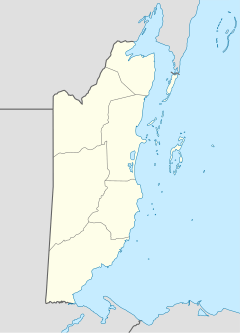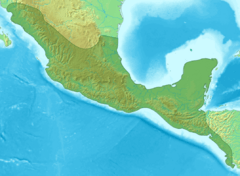Tzibte Yux facts for kids

Longitudinal diagram of Tzibte Yux / excavation units 1–9 labelled / 2019 Prufer et al. / via PLOS ONE
|
|
| Alternative name |
|
|---|---|
| Location | Rio Blanco National Park, Toledo, Belize |
| Region | Yucatan Peninsula |
| Coordinates | 16°13′45″N 89°05′36″W / 16.22918291312578°N 89.09335790400635°W |
| Type | Rock shelter |
| Length | 121 ft (37 m) |
| Width | 14.8 ft (4.5 m) |
| History | |
| Founded | 10500 BC |
| Abandoned | 6500 BC |
| Periods | Preceramic |
| Cultures | Palaeoindian |
| Site notes | |
| Discovered | 2009 |
| Excavation dates | 2012–2015 |
| Archaeologists | Keith Prufer / Uxbenka Archaeological Project |
| Ownership | Public |
| Management | Institute of Archaeology |
| Public access | Limited |
Tzibte Yux, also known as Tzib Te Yux or Tzib'te Yux, is an ancient rock shelter and archaeological site. It is located in the Rio Blanco National Park in Toledo, Belize. This site was used by early people, known as Palaeoindians, a very long time ago. They lived there during the Preceramic Period, which was from about 10,500 BC to 6,500 BC.
Contents
What is Tzibte Yux?
Tzibte Yux is a natural rock shelter. It is about 37 meters (121 feet) long and 4.5 meters (14.8 feet) wide at its widest point. The entrance to the shelter is protected by a large overhang made of strong rock. This overhang is like a natural roof.
How the Shelter Was Formed
The rock overhang is made of a type of rock called silicified limestone and conglomerate. This means it's a mix of hardened limestone and other small rocks cemented together. The entrance is usually about 7.9 meters (26 feet) above the Blue Creek during the dry season. However, in the wet season, the water level rises, and it can be less than 1.8 meters (6 feet) above the creek.
The Floor of the Shelter
The floor inside the shelter is mostly flat. It is made up of layers of dirt and other materials. A lot of these materials are shells from jute snails. These shells were left behind by the people who lived there long ago, before Christopher Columbus arrived in the Americas.
Tools and Discoveries
Archaeologists have found ancient stone tools at Tzibte Yux. These tools are called "bifacial points" because they were shaped on both sides. They include "Fishtail-style" and "Lowe-style" points. The Fishtail-style tools are very old, dating back to about 10,450 BC to 10,085 BC. The Lowe-style tools are a bit newer, from about 8,275 BC to 6,650 BC. Scientists have also found human remains in the rock shelter, which helps us learn about the people who lived there.
How We Study Tzibte Yux
The Uxbenka Archaeological Project discovered Tzibte Yux in 2009. This team of archaeologists then started studying the site in more detail.
Digging for Clues
From 2012 to 2015, archaeologists carefully dug up parts of the shelter floor. They divided the floor into nine sections, or "units," for their digging. These units covered about 18 square meters (194 square feet) of the floor. They dug down about 0.75 meters (2.5 feet) deep on average.
Dating the Past
During their digs, they found a piece of charcoal in one section, Unit 1. This charcoal was found deep down, about 58 centimeters (23 inches) below the surface. Scientists used special tests to find out how old it was. They discovered it dated back to about 10,571 BC to 10,526 BC. Most of the other things found in the other units also dated to the period between 10,500 BC and 6,500 BC. This helps us understand when people lived in Tzibte Yux.



